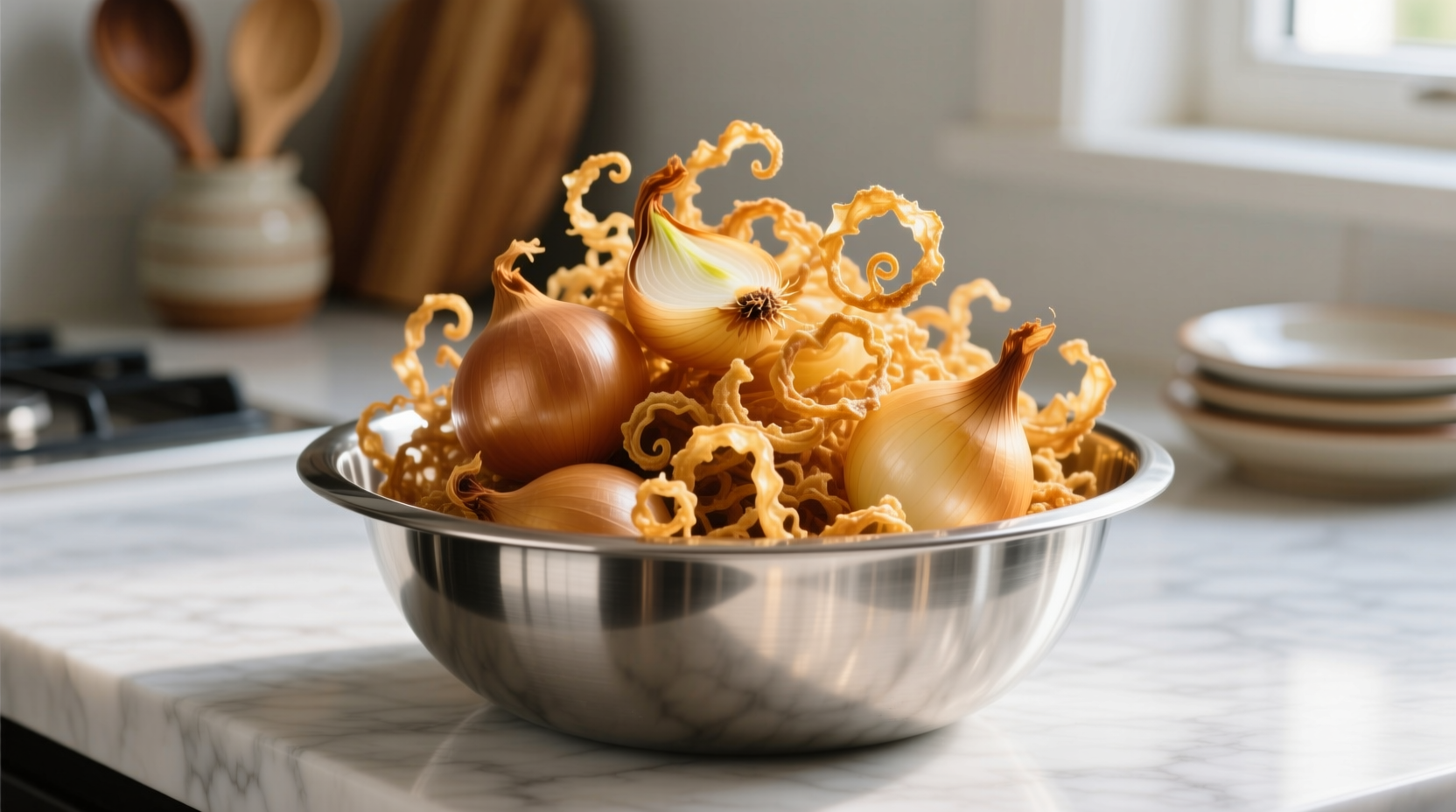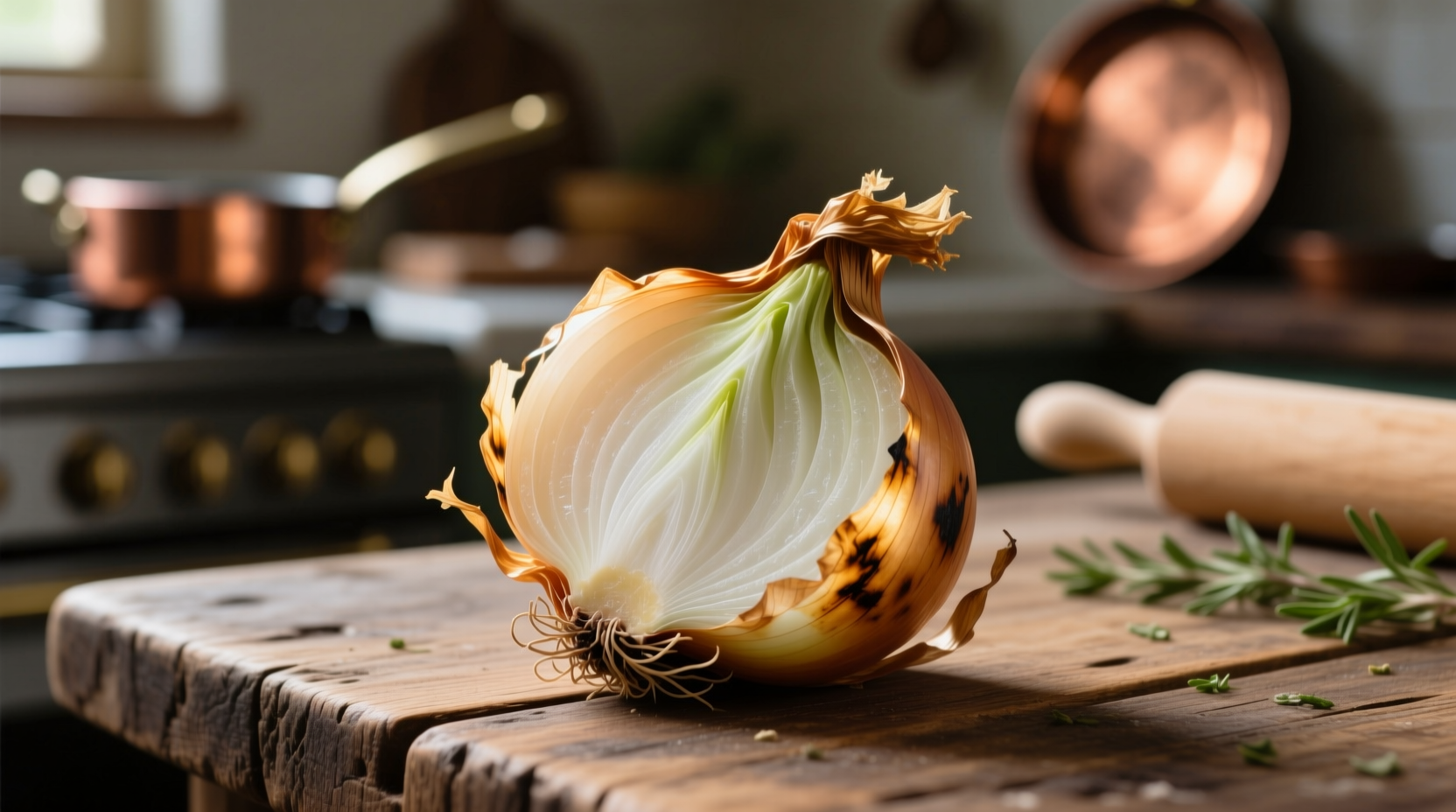Discover how to transform ordinary onions into restaurant-quality crispy toppings with this comprehensive guide. Whether you're garnishing Asian noodle bowls, topping burgers, or adding crunch to salads, mastering frizzled onions unlocks new dimensions in home cooking. Professional chefs rely on this simple technique to add texture contrast and concentrated onion flavor without overwhelming dishes.
What Exactly Are Frizzled Onions?
Frizzled onions, sometimes called crispy fried onions or onion strings, are created by slicing onions paper-thin, separating the rings, and deep-frying them in hot oil until golden and crisp. Unlike caramelized onions which develop sweetness through slow cooking, frizzled onions maintain their sharp onion flavor while gaining a delicate crunch. This culinary technique appears in diverse food traditions worldwide—from Indian biryanis to Filipino pancit dishes and Middle Eastern mujadara.
| Onion Type | Best For Frizzling | Flavor Profile | Texture Result |
|---|---|---|---|
| Yellow Onions | ★★★★★ | Balanced sweet-sharp | Consistently crisp |
| Red Onions | ★★★☆☆ | Sharper, more pungent | Slightly less crisp |
| Shallots | ★★★★☆ | Sweeter, more delicate | Delicate, lacy texture |
| Green Onions | ★★☆☆☆ | Milder, grassy notes | Quick-cooking, less crisp |
The Science Behind Perfect Frizzling
Creating ideal frizzled onions requires understanding the Maillard reaction and moisture control. When onions hit hot oil (350-375°F), surface moisture instantly vaporizes while sugars and amino acids undergo browning reactions. The key is maintaining precise oil temperature—too cool and onions absorb excess oil becoming greasy; too hot and they burn before crisping. According to the USDA's National Nutrient Database, frying reduces onion moisture content from 89% to just 3-5%, concentrating flavor while creating that signature crunch.

Step-by-Step Frizzling Technique
Follow this chef-tested method for consistently perfect results:
- Preparation: Chill onions for 30 minutes before slicing—this reduces tearing and creates cleaner cuts. Use a mandoline set to 1/16-inch thickness for uniform slices.
- Drying: Separate rings and spread on paper towels. Pat thoroughly dry—any surface moisture causes oil splatter and prevents crispness.
- Oil Temperature: Heat neutral oil (like peanut or canola) to 365°F in a deep pot. Maintain this temperature using a candy thermometer.
- Frying: Add small batches (¼ cup) to avoid temperature drop. Fry 60-90 seconds until golden, stirring gently with a spider strainer.
- Draining: Immediately transfer to paper-lined tray. Sprinkle with fine sea salt while still warm.
Avoiding Common Frizzling Mistakes
Even experienced cooks encounter these pitfalls:
- Soggy results: Caused by insufficient drying or oil temperature below 350°F. Solution: Double-dry slices and monitor oil temperature constantly.
- Burnt edges: Occurs when oil exceeds 380°F. Solution: Remove pot from heat briefly to cool oil between batches.
- Clumping: Happens when overcrowding the fryer. Solution: Fry in small batches with ample oil space.
- Bitter taste: Results from reusing oil beyond smoke point. Solution: Discard oil after 2-3 uses for frizzling.
Culinary Applications Beyond Garnish
Expand your cooking repertoire with these professional applications:
- Texture contrast: Sprinkle over creamy soups or purees for sensory interest
- Flavor layering: Incorporate into burger patties or meatloaf for bursts of onion flavor
- Binding agent: Mix with breadcrumbs for extra-crispy coatings on proteins
- Salad enhancement: Toss with warm vinaigrette-coated greens for restaurant-style presentation
Storage and Shelf Life Guidelines
Proper storage maintains crispness and flavor:
| Storage Method | Duration | Quality Preservation | Best For |
|---|---|---|---|
| Airtight container at room temperature | 1-2 weeks | ★★★★☆ | Immediate use |
| Freezer (vacuum sealed) | 3-4 months | ★★★★★ | Long-term storage |
| Refrigerator | 3-5 days | ★☆☆☆☆ | Avoid—causes sogginess |
Revive slightly stale frizzled onions by spreading on a baking sheet and heating at 300°F for 3-5 minutes. Never microwave, as this creates uneven texture and potential fire hazards.
Health Considerations for Home Cooks
While frizzled onions add delicious texture, consider these nutritional aspects. According to the USDA FoodData Central database, 1 tablespoon (6g) of homemade frizzled onions contains approximately 30 calories, 3g fat, and 2g carbohydrates. The frying process concentrates natural sugars while reducing water content. For lower-fat versions, try oven-baking thinly sliced onions at 400°F with light oil spray until crisp—though this method yields less consistent results than deep-frying.
FAQs About Frizzled Onions
Can I make frizzled onions without deep-frying?
Yes, though results differ. Oven-baking at 400°F with light oil spray takes 15-20 minutes but produces less uniform crispness. Air frying works better—toss thinly sliced onions with 1 tsp oil and cook at 375°F for 8-10 minutes, shaking basket periodically. Neither method achieves the same delicate texture as proper deep-frying.
Why do my frizzled onions turn out soggy?
Sogginess typically occurs from three issues: insufficiently dried onion slices, oil temperature below 350°F, or overcrowding the fryer. Ensure onions are thoroughly patted dry before frying. Maintain oil at 365°F using a thermometer, and fry in small batches (¼ cup per batch) to prevent temperature drops that cause oil absorption.
Which onion variety works best for frizzling?
Yellow onions produce the most consistently crisp results due to their balanced sugar content and firm texture. Shallots create delicate, lacy frizzles ideal for gourmet dishes. Red onions work but yield slightly less crisp results. Avoid sweet onions like Vidalias which contain more moisture and caramelize too quickly, burning before crisping.
How can I prevent frizzled onions from burning?
Maintain precise oil temperature between 350-375°F using a candy thermometer. Remove the pot from heat briefly between batches to prevent temperature creep. Fry in small batches to avoid cooling the oil. Watch closely during the final 15 seconds—onions go from golden to burnt rapidly. Have a spider strainer ready for immediate removal when edges turn golden.
Can I reuse oil after making frizzled onions?
Yes, but with limitations. Strain cooled oil through cheesecloth to remove particles. Reuse 2-3 times for similar applications (other onion frying or neutral-flavored foods). Discard if oil darkens significantly, develops off-odors, or smokes below 350°F. Never reuse for delicate tasks like frying fish, as onion flavor will transfer to subsequent foods.











 浙公网安备
33010002000092号
浙公网安备
33010002000092号 浙B2-20120091-4
浙B2-20120091-4